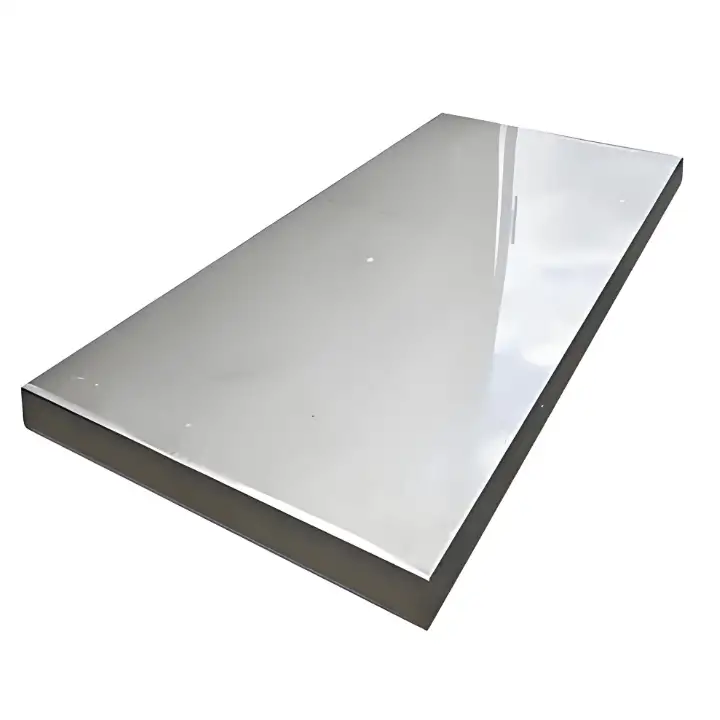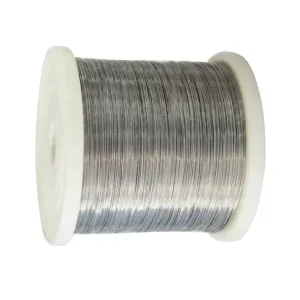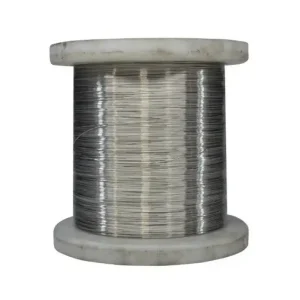Hastelloy X is a nickel–chromium–iron–molybdenum solid‑solution superalloy known for its remarkable high‑temperature strength, oxidation resistance, and fabricability. At MWalloys, we supply custom Hastelloy X in plates, bars, rods, coils, wires, and pipe—engineered for gas‑turbine, petrochemical, and furnace applications.
What Is Hastelloy X?
Hastelloy X is a wrought nickel‑base alloy with nominal composition: Ni remainder; Cr 20.5–23 %; Fe 17–20 %; Mo 8–10 %; Co 0.5–2.5 %; W 0.2–1 %; plus minor Mn, Si, Ti, Al, C, P, S, B.
Specifications & Parameters
| Category | Property | Value / Specification | Notes / Conditions |
|---|---|---|---|
| Chemical Composition | Nickel (Ni) | Balance (≥47%) | Primary constituent |
| Chromium (Cr) | 20.5–23.5% | Key for oxidation resistance | |
| Iron (Fe) | 17.0–20.0% | Stabilizes austenitic matrix | |
| Molybdenum (Mo) | 8.0–10.0% | Enhances corrosion/creep resistance | |
| Tungsten (W) | 0.2–1.0% | Solid-solution strengthening | |
| Cobalt (Co) | 0.5–2.5% | Optimizes high-temp strength | |
| Carbon (C) | ≤0.05–0.15% | ||
| Manganese (Mn) | ≤1.0–1.5% | ||
| Silicon (Si) | ≤0.4–1.0% | ||
| Physical Properties | Density | 8.22–8.30 g/cm³ | |
| Melting Range | 1295–1381°C (2363–2518°F) | ||
| Thermal Conductivity | 11.2–14.4 W/m·K | Range: RT (11.2) to 1000°C (14.4) | |
| Coefficient of Thermal Expansion | 12.1–13.3 × 10⁻⁶/°C | Measured at 20–100°C | |
| Specific Heat Capacity | 377–449 J/kg·K | At 25°C | |
| Elastic Modulus | 199–220 GPa | ||
| Electrical Resistivity | 1.18–1.28 μΩ·m | At 20°C | |
| Mechanical Properties | Tensile Strength (RT) | 690–760 MPa (min) | Annealed/solution-treated |
| Yield Strength (0.2% Offset, RT) | 275–340 MPa (min) | ||
| Elongation (RT) | 30–48% (min) | ||
| Hardness | 195–241 HB | Brinell; annealed state | |
| High-Temperature Performance | Continuous Service Limit | 900°C (1652°F) | Long-term use |
| Short-Term Service Limit | 1080°C (1976°F) | ||
| Stress Rupture Strength (870°C) | ≥65 MPa | 1000h duration | |
| Creep Rate (870°C) | 0.0003%/h | At 24.1 MPa | |
| Heat Treatment | Solution Annealing | 1150–1177°C (2100–2150°F), rapid air/water cool | For sheet/bar |
| Stress Relief | 870°C (1600°F), 30–60 min, air cool | Post-welding/machining | |
| Fabrication | Welding Methods | GTAW, GMAW, resistance welding Filler: Hastelloy X or ERNiCrMo-11 47 |
Pre-weld cleaning mandatory |
| Hot Working | 1170°C (2140°F) max, ≥950°C (1742°F) finish | Forging/rolling | |
| Cold Working | Intermediate annealing required | Due to high work-hardening rate | |
| International Standards | Bar/Rod | ASTM B572, AMS 5754 | Aerospace grade |
| Plate/Sheet/Strip | ASTM B435, AMS 5536 | ||
| Seamless/Welded Tube | ASTM B619/B622/B626, AMS 5587 | ||
| Forgings | ASTM B564 | ||
| Key Applications | Aerospace | Combustors, turbine shrouds, afterburners | Jet engines (e.g., GE, Rolls-Royce) |
| Industrial Furnaces | Radiant tubes, burner grids, rollers | Petrochemical/heat treatment | |
| Energy | Gas turbine components, nuclear reactor parts | High-temperature stability | |
| Chemical Processing | Heat exchangers, reactor vessels | Acid-resistant equipment |
🔑 Critical Notes & Variability Factors
-
Compositional Ranges:
-
Minor elements (e.g., Al ≤0.50%, Ti ≤0.15%) vary by standard; nuclear/aerospace grades enforce stricter controls.
-
Iron content (17–20%) is higher than typical Ni-based alloys, enhancing cost-effectiveness while maintaining performance.
-
-
Mechanical Property Discrepancies:
-
Strength/Elongation: Higher tensile/yield values (e.g., UTS 760 MPa) reflect optimized processing or AMS specifications; ASTM minima are conservative.
-
High-Temp Data: Stress rupture strength drops to ~40 MPa at 980°C; creep accelerates above 900°C.
-
-
Fabrication Constraints:
-
Welding: Low heat input (≤100°C interpass temp) prevents cracking; post-weld annealing required for severe corrosive service.
-
Oxide Removal: Surface oxides adhere strongly; grit blasting or electrochemical polishing recommended.
-
-
3D Printing Compatibility:
-
Powder variants (15–150 µm) exhibit ≥98.5% sphericity and high flowability; layer thickness: 15–50 µm.
-
💎 Summary: Hastelloy® X excels in extreme heat (≤1080°C) with unmatched oxidation resistance and weldability, driven by its Ni-Cr-Mo-Fe matrix. Its niche dominance in aerospace combustors and industrial furnaces stems from balanced creep strength (e.g., 0.0003%/h at 870°C) and manufacturability. For nuclear/defense applications, consult AMS 5754 for enhanced traceability.
global price comparison
| Form | China (USD/kg, FOB) | Europe (USD/kg) | USA (USD/kg) | India (USD/kg) |
|---|---|---|---|---|
| Plate/Sheet | $35/kg for 30 mm plate (100 kg MOQ) | $28/kg (~£24/kg) | — | $58/kg (~₹4,000/kg) |
| Bar / Rod | $18/kg FOB round bar | $28–35/kg bar listings | $30/kg (~₹7,000/kg) | $58/kg (~₹4,000/kg) |
| Coil / Strip | $10–20/kg OEM aerospace coil wire | $28–35/kg estimated coil/strip | — | — | | ||
| Wire | $10–20/kg aerospace wire; $28–35/kg standard wire | $29–37/kg estimated wire | $30/kg (~₹7,000/kg) | — |
🔍 Insights
-
China offers highly competitive pricing, with plate at $35/kg and bar as low as $18/kg—plus coil/wire from $10–20/kg in aerospace or bulk quantities.
-
Europe prices generally span $28–35/kg, depending on form and certification.
-
USA distributors quote around $30/kg for bars and tubes.
-
India shows higher pricing, at approximately $58/kg (~₹4,000/kg) across plates, bars, and tubes.
📌 Note: Prices vary with quantity, surface finish, certification (e.g., AMS 5754/572), and market conditions. For exact factory-direct quotes with MTCs and lead times, please contact MWalloys—usually within 24 hours.
Why Choose Hastelloy X?
-
Outstanding Oxidation Resistance: Forms tenacious oxide film up to 1200 °C.
-
High‑Temperature Strength: Maintains tensile strength > 700 MPa up to 816 °C (1500 °F).
-
Fabricability: Excellent weldability (GTAW, GMAW, SMAW) and formability with minimal cracking risk.
-
Corrosion and SCC Resistance: Good resistance to chloride stress‑corrosion cracking in petrochemical service.
Manufacturing & Forming
-
Hot Working: 1100–1220 °C; avoid excessive grain growth.
-
Cold Working: Improves strength; follow with solution annealing at 1177 °C (2150 °F).
-
Heat Treatment: Solution anneal at 1177 °C; rapid quench; optional aging at 650–870 °C for enhanced creep resistance.
Comparison with Similar Alloys
| Property | Hastelloy X | Inconel 625 | Inconel 718 |
|---|---|---|---|
| Oxidation Limit | 1200 °C | 980 °C | 700 °C |
| Tensile @ RT | 755 MPa | 1030 MPa | 1100 MPa |
| Creep Resistance | Superior in carburizing | Excellent | Excellent |
| Fabricability | Excellent | Good | Good |
Welding Practices
Use matched filler (ERNiCrMo‑3), clean joint surfaces, and control heat input. Post‑weld annealing at 1177 °C is optional but can restore maximum corrosion resistance.
FAQs
1. What is the service temperature limit and oxidation behavior of Hastelloy X?
Hastelloy X maintains strength and excellent oxidation resistance up to approximately 1,200 °C (2,200 °F). In tests, furnace rolls made from X remained in good condition after 8,700 hours at 1,177 °C, demonstrating its high-temperature stability.
2. How resistant is Hastelloy X to carburization and nitriding?
The alloy shows superior resistance: after 100 hours in petroleum coke, it was the only tested material that showed no carburization. In ammonia/nitrogen atmospheres at high pressure, its nitride case was minimal—about ¼ the thickness of comparative alloys.
3. Is Hastelloy X susceptible to stress-corrosion cracking?
No. It exhibits exceptional SCC resistance in petrochemical and chloride-rich environments. Its homogenous solid-solution microstructure minimizes crack initiation pathways.
4. How weldable is Hastelloy X, and are heat treatments needed post-fabrication?
Very weldable. It accepts GTAW, GMAW, SMAW, and resistance welding. Hot work restoration steps are recommended but solution annealing isn't always required unless maximum corrosion resistance is critical.
5. What are the fatigue and tensile characteristics, including at elevated temperatures?
At room temperature, Hastelloy X has a tensile strength of ~755 MPa and yield ~385 MPa, with approximately 22% elongation. It also demonstrates robust high-cycle fatigue performance at 750 °C, especially when produced via advanced methods like laser-powder-bed fusion.
6. In which industrial sectors is Hastelloy X most commonly used?
Hastelloy X excels in:
-
Gas turbines: combustor liners, ducting, frames.
-
Industrial furnaces: trays, rolls, baskets, muffles enduring oxidizing/carburizing environments.
-
Petrochemical plants: heat exchangers, retorts in challenging atmospheres.





